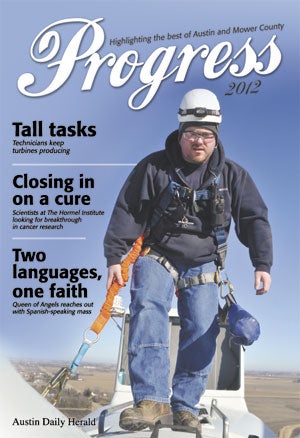Austin schools: Space to grow
Published 12:34 pm Thursday, March 1, 2012

Mark Stotts, Austin Public Schools finance and operations director, has been a driving force in getting a new school built to deal with overcrowding. --Eric Johnson/phtoodesk@austindailyherald.com
School district thankful for public’s support of new school
This story originally appeared in Progress 2012, which published Sunday, Feb. 26.
Thanks to the citizens of Austin, schoolchildren will have enough space to learn.
That’s what many Austin Public School staff and supporters of last November’s $28.9 million bond referendum believe. Voters decided to support a new fifth- and sixth-grade school, along with a Woodson Kindergarten Center expansion, so the space crunch felt in many Austin schools would go away.
“There wouldn’t have been a project without the voter approval,” said Superintendent David Krenz.
The process hasn’t been easy, however. Just ask Mark Stotts, finance and operations director.
“Going into that process, we really didn’t know where it was going to lead,” Stotts said. “Yeah, we internally kicked around ideas, but when we started the process, I never thought it would end up like it did.”
The whole thing began when demographer Hazel Reinhart gave a report on Austin’s projected student population in 2009, around the time district officials wondered if the increase in students they saw would continue. Reinhart’s report was clear: Based on the amount of births in Mower County, Austin schools were going to see an increase in students.
What district officials didn’t know was how right she was. Though Reinhart’s population projections showed four possible growth patterns ranging from slight to heavy student increases, the district’s student population has consistently been either at or above Reinhart’s largest projection.
In 2009, the district had 4,417 students start school, compared to Reinhart’s high-end projection of 4,464. The district taught 4,439 students in September 2010, compared to Reinhart’s estimated high of 4,399. Austin schools greeted 4,467 students last September, 12 students fewer than the demographer’s highest projection of 4,479.
Those numbers are huge, seeing as the district’s overall space is shrinking. A facility usage report done by November 2010 showed every Austin school except Austin High School was at or over capacity.
Residents know the story from there. A community-led facilities task force composed of residents and school administrators looked at possible solutions to Austin’s space issues, created the idea for an intermediate school and Woodson expansion, and brought the measure to voters in November.
“This wasn’t just a slam dunk,” Stotts said. “We had to work pretty darn hard to get this committee to a consensus.”
Stotts led the group, researched the costs, filed the proper paperwork for a Minnesota Department of Education review, got the financing ready and is coordinating with architects, construction managers and new general contractor Wagner Construction of Austin on the Woodson expansion, among other things. Krenz made speeches and talked with countless citizens about the benefits. Other school staff either helped with a “Vote Yes” committee or told their friends and neighbors about the referendum. Though the work for a new school will continue for years, district officials are happy Austin’s residents are involved in the school, and last November’s votes showed what they thought.
“Any time that we are a public school — a public institution proposing an idea — the public needs to be a part of the process,” Krenz said.






